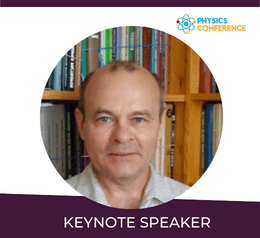Scholars International Conference on
PHYSICS AND QUANTUM PHYSICS
THEME: "Frontiers in Physics and Quantum Physics"
 22-23 Jun 2022
22-23 Jun 2022  NH Potsdam, Berlin, Germany & Online
NH Potsdam, Berlin, Germany & Online THEME: "Frontiers in Physics and Quantum Physics"
 22-23 Jun 2022
22-23 Jun 2022  NH Potsdam, Berlin, Germany & Online
NH Potsdam, Berlin, Germany & Online 
Moscow Institute of Physics and Technology, Russia
Title: Non-radiative transitions in excited states of NV--center in diamond crystals
Yury M. Belousov (Dr. habil.) graduated from Moscow Institute of Physics and Technology and currently is a Professor of Theoretical Physics Department in MIPT. His work focuses on the magnetic relaxation and muon studies of condensed matter (µSR-Method), spin-systems dynamics, quantum chemistry and quantum measurements. He is the author and coauthor of more the 100 scientific publications. The results are outlined in two monographs: The Muon Method in Science (1993, NY, Nova Science) and Study of High-Tc Superconductors By µSR-Technique (2003, London and New York, Taylor & Francis). He is also the author and co-author of many books among them Problem Solving in Theoretical Physics (2020, Willey-VCH).
There are many point defects (impurities) in diamond crystals, and their classi_cation and electronic properties are described in detail in the review. The greatest interest among them was caused by the vacancy color center formed by the nitrogen atom, NV-, which is associated with the possibilities of its application in various areas of quantum technology physics.
These applications are mainly related to the observed optical transitions between the electronic energy levels of the center. In particular, the optical properties of the NV- center are supposed to be applied to the implementation of quantum gates and keys for quantum cryptography.
The ground energy level of the center 3A2 is a spin triplet. Therefore, first of all, there is an optical transition from the excited triplet energy level 3E to the main one, which corresponds to a change in energy ?E =1.945 eV. In addition to this main transition, an optical transition between spin singlet levels 1A1 ? 1E is also observed and corresponds to a change in energy ?E = 1.190 eV. No spin-singlet energy levels cannot be excited by optical interaction from the ground spin-triplet level. So, nonradiative transition from the excited triplet energy level to the excited singlet level should exist.
A mechanism of nonradiative transition between the excited energy levels of NV--centers in diamond crystals is proposed. A nonradiative transition between the spin triplet and singlet levels is possible as a result of spin-orbit interaction with simultaneous excitation of vibrational (vibronic) states of the cluster and excitations of lattice phonons. Therefore, such a transition can be obtained in the second order of perturbation theory. To describe this process, the spin-vibronic interaction operator is obtained, and non-zero matrix elements providing non-radiative transitions are calculated. It is obtained that matrix elements are proportional to the overlap integrals of one-electron wave functions. It is shown that the transition rates 3E ?1A1 and 1E ?3A2 are determined by the same expressions. Thus, the nonradiative transitions under consideration aredetermined not by a multiphonon process, but by the excitation of the vibrational states of the NV--center atoms. Numerical estimates give good agreement with experimental data.